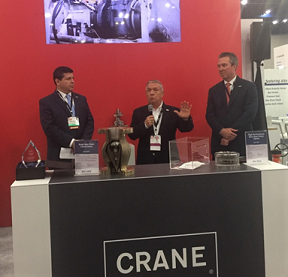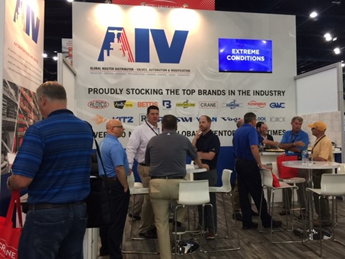Highlights from the 2019 Valve World Americas Expo & Conference
Speakers from end-user companies, consultants and repair/maintenance companies, as well as valve manufacturers and their suppliers, presented at the Valve World Americas conference.
#maintenance-repair
Three of the keynote speakers shared their experience with management issues, including Tim Goedecker, chairman of the Valve World Americas Expo & Conference 2019 and senior principal environmental consultant of refining health, safety and education at Phillips 66. He spoke about the learning and working styles of the various generations of workers currently on the job.
John Bowhay, senior vice president at MRC Global, offered in his keynote perspectives on the global market for pumps, valves and fittings. Last year, valves represented 37% of the market. Currently, demand does not match supply, he said. Much will depend on what happens with tariffs in the U.S. and other countries. He also discussed how distributors add value by aggregating orders into volumes that allow leverage in purchase terms, a topic that was presented in more depth in another session. Regarding the supply chain, which also was covered in other sessions, he pointed out the importance of auditing not only the manufacturers a company buys from, but the suppliers to those manufacturers.
Newer technologies, additive manufacturing (3D printing) and magnetic valve actuation, piqued the interest of many attendees.
Jukka Borgman from Metso presented on how 3D printing is becoming a mature technology for valve manufacturers to use and how it adds value for valve users. A speaker from 3D Metalforge outlined using additive manufacturing to drive efficiency and cost savings for the valve industry.
Two presentations focused on magnetic valve actuation, a technology that allows valves to be completely sealed, eliminating fugitive emissions, according to Ned Davis of Maui Innovation Group, speaking in the new technologies session, and David Yakos of MagDrive Solutions, who presented in one of the fugitive emissions sessions.
A CASE STUDY OF ENVIRONMENTAL COMPLIANCE
Carl Anderson, environmental engineer for Par Hawaii Refining, covered the experience of dealing with alleged violations of the Clean Air Act at six refineries. In 2016 Par Hawaii and parent company Tesoro Corp reached a settlement with the Environmental Protection Agency and U.S. Department of Justice. Under the settlement, Anderson said, the companies will spend about $403 million to install and operate pollution control equipment.
Compliance included installing certified low-leaking technology (CLLT) valves throughout the refineries. Other changes involved updating the approved manufacturers list, purchasing procedures and engineering standards. Non-CLLT valves needed to be removed and sequestered. The valve replacement/improvement program included not only dealing with the valves themselves, but also training for employees involved in leak detection and repair work. As is often the case in refining, manufacturing and similar industries, a continuing challenge is to convince people to adopt and continue to use new procedures. “In a complicated workflow, there are many ways to fail and only one way to succeed,” he said.
EFFECTIVE SITE VISITS TO SUPPLIERS
How to make effective vendor visits was the topic presented by Ron Merrick, a senior fellow at Fluor Corporation, an engineering, procurement, fabrication, construction and maintenance company. In addition to outlining the basics of visiting, observing, inquiring and reporting, Merrick offered tips and insight. For example, he suggested to “look at rejects as well as good parts.” If there are no rejects—or a great many rejects—this could indicate trouble. He spoke specifically about the difficulty of evaluating foundries. Merrick pointed out that visitors during normal working hours are unlikely to see parts being poured, as most foundries do most of their pouring at night when the electricity cost tends to be lower.
SELECTING THE RIGHT VALVES
Presentations also offered guidelines on specifying different kinds of valves, coatings or accessories.
Sean Croxford, business unit manager at Farris Engineering Services, Curtiss-Wright Flow Control Company highlighted the difference between pressure safety valves (PSVs) for liquid and vapor service. “Liquid service valves do not pop in the same manner as vapor service valves, since the expansive forces produced by vapor are not present in liquid flow.” When the valve is closed, the forces acting on the valve disc are the same regardless of whether the process fluid is a liquid or vapor. However, once the pressure rises to offset the force holding the seat closed, the forces involved are quite different for liquid and vapor. To achieve the desired performance, the spring rate and internal trim geometry and the springs used are different. PSVs for vapor have stiffer springs and PSVs for liquid have less stiff springs, allowing for greater deflection, Croxford said. Some PSVs will need to deal with both liquid and vapor, sometimes together as 2-phase flow. PSVs for this scenario need to be specified with care to make sure they work properly in all circumstances.
Taking an integrated approach to valve selection can solve many valve challenges in the plant, said Shonna Victoria, an industrial engineer with chemical company LyondellBasell. She described using a software tool that uses qualitative and quantitative information to select valves for a process, including vendor reliability. Another presenter, consultant Henk Hinssen, reminded the attendees to “work vendor-independent; think valve types, not vendors.” The best valves for the process might not all come from the same vendor.
A GOOD SHOW FOR VMA AND ITS MEMBERS
Through the course of the event, staff spoke to many of the approximately 35 members scattered throughout the exhibit hall. Most agreed that traffic at the expo had improved from past events though some indicated they would like to have seen more end users. Even so, having face-to-face time with customers and relationship-building with others in the industry, according to one VMA member that exhibited, is an important factor for those assessing their involvement in the expo.
Most members who were asked, "how's business?" responded that things were going well, and some said they could barely keep up with orders; one member mentioned how they were being held back because of the difficulty in finding key staff—a common refrain.
The next Valve World Americas Expo & Conference will be held in 2021.
Judy Tibbs is editor-in-chief of VALVE Magazine and VMA’s director of education. Barbara Donohue is web editor for VALVEmagazine.com.
RELATED CONTENT
-
The Evolution of the All-Encompassing Ball Valve
The compact design, simplicity of use, ease of repair and wide performance capability have helped to make the ball valve a dominant design in modern industrial applications.
-
Actuator Issues? Use This Checklist!
While there may be 40 reasons valve actuators may stop working, there really is only a handful of components that can cause the problems. So, if you have an actuator on the fritz, here are the five things you need to check.
-
Valve Selection for Bypass of Control Valves: A Case Study
A bypass line including a bypass valve is typically installed to provide continuous operation in case of regular maintenance of a control valve.










 Unloading large gate valve.jpg;maxWidth=214)


